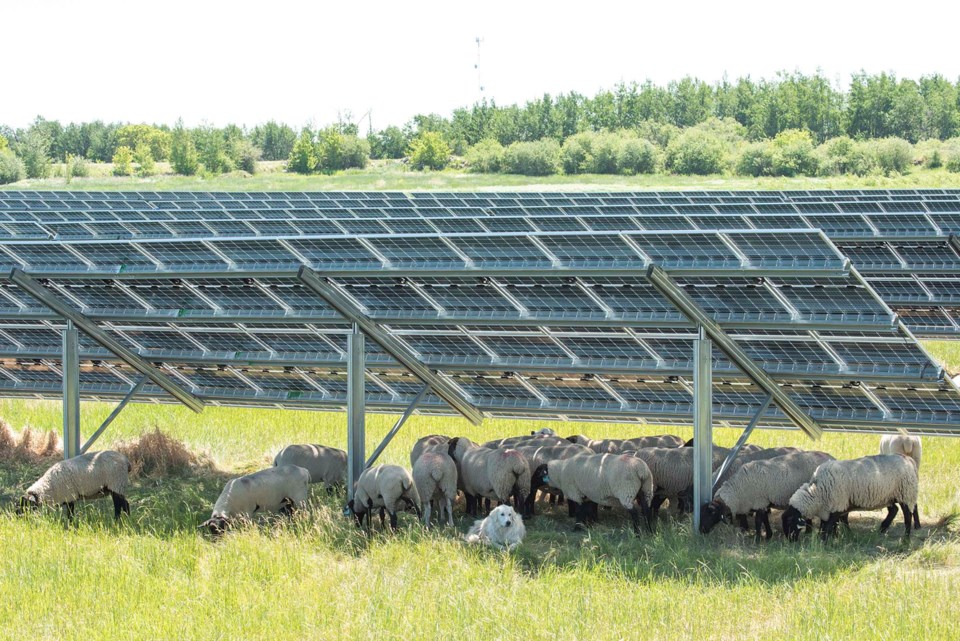How Now Green Cow
How Now Green Cow is examining how global heating how our dinners are shaping, and are being shaped by, the climate crisis. Got a food and climate question? Send it to [email protected] so it can be addressed in a future story.
Can farmers harvest food and the sun at the same time?
That’s a question some Albertans might have after driving past a big solar array built on farmland. If we’re using land to produce clean energy, does that mean less land for food?
Not necessarily. Done properly, farmers can raise food and produce power on the same patch of land using agrivoltaics. The Town of Bon Accord did by using sheep to mow the grass under its solar array from 2021 to 2022.
“It was great having sheep there,” said town CAO Jodi Brown, as they saved the town money on mowing and gave the sheep grass to eat.
Janna Greir of Solar Sheep Inc. has been using sheep to mow the grass at the Strathmore Solar array for about three years now. The array’s owners (Capital Power) save money on mowing, while she earns money for her services and gets more land to raise more sheep.
“It’s allowed us to grow our business,” Greir said.
Powering up crops
Agrivoltaics is the use of solar panels to increase crop yield, said Joshua Pearce, a researcher of solar technology at Ontario’s Western University and co-founder of Agrivoltaics Canada. You do this by calculating how much sun, wind, heat, and water a crop needs, and using panels as fences and shades to create those ideal growing conditions.
Pearce said researchers have found that properly designed on-farm solar arrays can significantly improve yields in crops such as basil, broccoli, celery, corn, lettuce, pasture grass, potatoes, spinach, and wheat. One 2018 study of a solar farm in Oregon found grass under the panels was 90 per cent more abundant and 328 per cent more water efficient than unprotected grass.
“You can get massive increases in yield,” Pearce said.
Combining crops and solar gives farmers financial security in the form of ongoing revenue from power produced or lease payments from the array owner, said Mikhail Ivanchikov of Dandelion Renewables (builders of the Bon Accord array). Solar panels can also act as wind breaks to reduce soil erosion and improve land values.
Caution ahead
Solar and sheep don’t always work out. Morinville Hutterite Colony boss John Wurz said he pulled his sheep off the Bon Accord array in 2022 after a guardian dog went missing and about half the flock died.
“For me, it was more of a bother than anything,” he said of the on-array sheep, as he had to go out of his way to check in on the sheep.
Pearce said it’s not yet clear if agrivoltaics will work with every crop. Most research on it has happened outside of Canada, and there’s much work to be done to see if its benefits can be realized in this country. (His team is doing ongoing research in this area.)
Agrivoltaics with sheep also take work, Greir said. You need insurance to cover your sheep, enough staff and guardian dogs to protect them, and the right mix of grass under the panels to ensure proper nutrition. You also have to use rotational grazing (where you have animals intensively graze one region before moving then to another) to ensure the sheep eat all the grass, and not just the plants they like.
Farmers should tailor solar farm designs to their crops, Pearce said. Fixed panels might work for shade-loving lettuce, for example, while wheat might need long, widely spaced walls of panels (ideally ones that can pivot to track the sun) to give combines space to move.
Pearce said agrivoltaics has huge potential in Alberta. One study he led found Alberta could get almost all of its electricity from zero-carbon sources if it built agrivoltaic solar arrays on about 1.4 per cent of its farmland.
“Nobody wants to see good agricultural land paved over,” Pearce said, as that would raise food prices.
“I don’t think we should do normal solar farms anymore. We should do everything as agrivoltaics.”



